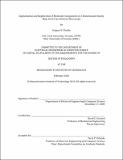| dc.contributor.advisor | David C. Gossard. | en_US |
| dc.contributor.author | Pintilie, Grigore Dimitrie, 1976- | en_US |
| dc.contributor.other | Massachusetts Institute of Technology. Dept. of Electrical Engineering and Computer Science. | en_US |
| dc.date.accessioned | 2010-08-26T15:19:48Z | |
| dc.date.available | 2010-08-26T15:19:48Z | |
| dc.date.copyright | 2010 | en_US |
| dc.date.issued | 2010 | en_US |
| dc.identifier.uri | http://hdl.handle.net/1721.1/57536 | |
| dc.description | Thesis (Ph. D.)--Massachusetts Institute of Technology, Dept. of Electrical Engineering and Computer Science, 2010. | en_US |
| dc.description | This electronic version was submitted by the student author. The certified thesis is available in the Institute Archives and Special Collections. | en_US |
| dc.description | Cataloged from student submitted PDF version of thesis. | en_US |
| dc.description | Includes bibliographical references (p. 89-93). | en_US |
| dc.description.abstract | Cryo-electron microscopy is a method that produces 3D density maps of macromolecular complexes. Segmentation and registration methods are heavily used to extract structural information from such density maps. Segmentation aims to identify regions in a density map corresponding to individual molecular components, so as to allow us to understand their complex arrangements and the relation of these arrangements to the function of the complex. Currently used segmentation methods rely to a large degree upon user interaction and thus are tedious and yield subjective results. We present a multi-scale segmentation method requiring very little interaction and guidance from the user. The segmentation accuracy of this method is quantified for simulated density maps, using a shape-based metric. The method is applied to several density maps of various sizes and complexity, producing accurate results. Registration of molecular structures with density maps helps to relate the vast structural information from X-ray crystallography with the structural information contained in cryo-electron microscopy density maps. The most reliable registration methods to date depend on exhaustive search, which is time-intensive and scales poorly with map and structure size. Two methods are presented that achieve direct registration of structures with density maps, based on the alignment of the structures to segmented regions. | en_US |
| dc.description.abstract | (cont.) The registrations are refined using a gradient-based method, which locally optimizes the density cross-correlation score. A search algorithm is presented for automatically finding groups of regions that produce correct registrations. The accuracy of these registration methods is measured using simulated density maps, and then the methods are used to register structures of individual proteins and subunits with density maps obtained by cryo-electron microscopy. | en_US |
| dc.description.statementofresponsibility | by Grigore D. Pintilie. | en_US |
| dc.format.extent | 93 p. | en_US |
| dc.language.iso | eng | en_US |
| dc.publisher | Massachusetts Institute of Technology | en_US |
| dc.rights | M.I.T. theses are protected by
copyright. They may be viewed from this source for any purpose, but
reproduction or distribution in any format is prohibited without written
permission. See provided URL for inquiries about permission. | en_US |
| dc.rights.uri | http://dspace.mit.edu/handle/1721.1/7582 | en_US |
| dc.subject | Electrical Engineering and Computer Science. | en_US |
| dc.title | Segmentation and registration of molecular components in 3-dimensional density maps from cryo-electron microscopy | en_US |
| dc.type | Thesis | en_US |
| dc.description.degree | Ph.D. | en_US |
| dc.contributor.department | Massachusetts Institute of Technology. Department of Electrical Engineering and Computer Science | |
| dc.identifier.oclc | 631235678 | en_US |
